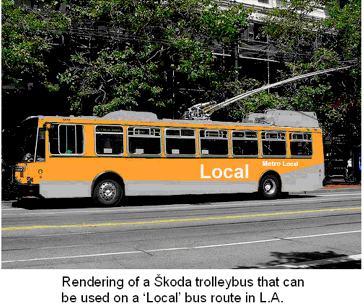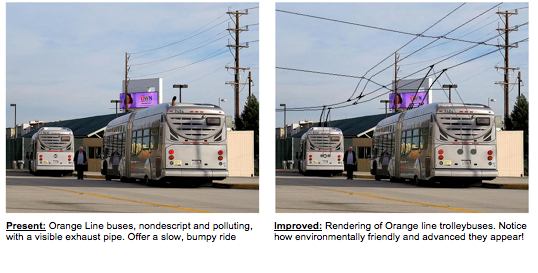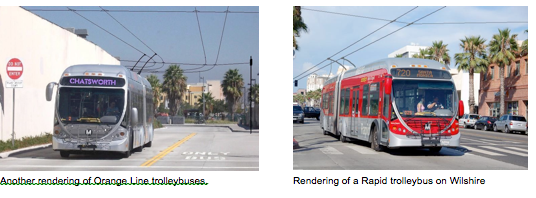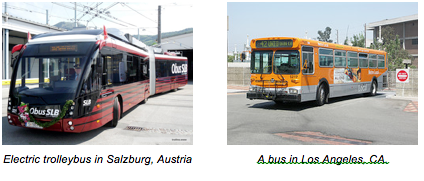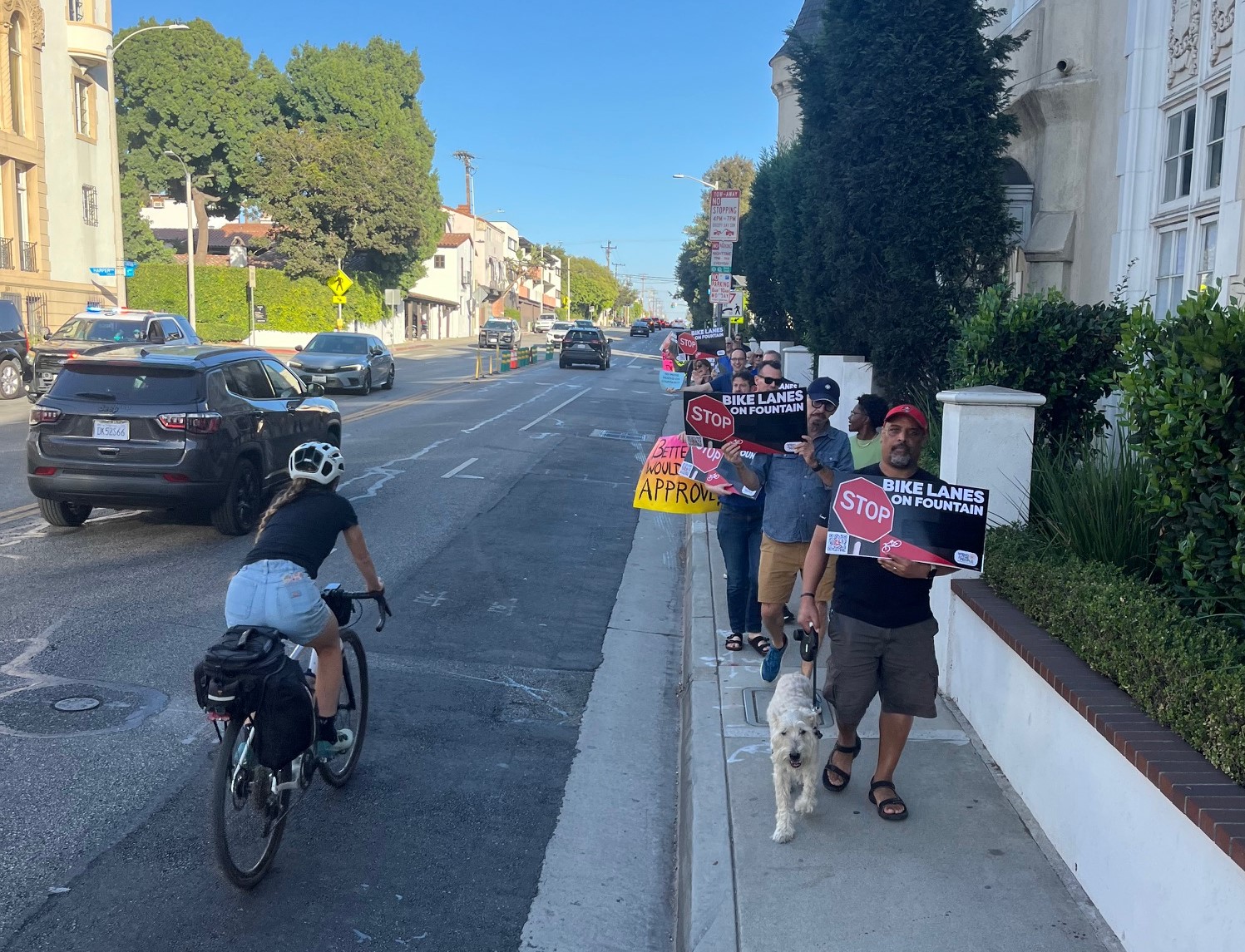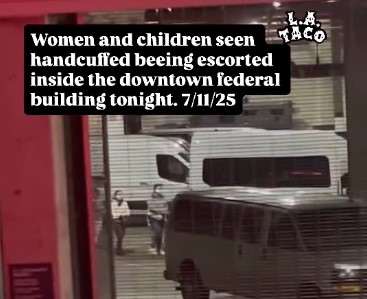[smooth=id:17; width:600; height:200; timed:true; arrows:true; carousel:true; links:true; info:true; align:center; frames:true; delay:9000; transition:crossfade; open:false; text:Thumbnails;]
Images of trolley buses from around the world, collected by Alexander Friedman.
Los Angeles is the 2nd largest city in the United States., both in population and size, and is still notorious for its “car culture.” Unlike other major world cities, our city cannot match the level of efficient alternatives to driving that many major world cities can. The few transit options we have are: two subway lines – Red and Purple; several light-rail lines, a clumsy BRT line; and an otherwise a slow & inefficient bus system.
What L.A. is missing is a reliable transit system, i.e. a citywide network of subway and light-rail lines, fully integrated with connecting buses. Investing in a citywide metro-rail network will require tens of billions of dollars, and decades to construct, and the government’s commitment. Our federal government isn’t too anxious to heavily invest in these projects due to many elected officials’ love of automobile. Our city and state funds can only provide a fraction of the investment. Hence we’re left with just a handful of rail lines and a cumbersome system of buses. Bus commutes involve transfers and sometimes hours to get across the city.
So, for the bad news: our mass transit isn’t getting much better anytime soon, except for several new rail lines & extensions in the next 10-30 years (depending on federal grants and loans availability). Given our city size and population, those planned projects are nowhere near what LA County ultimately needs.
Now, for some good news: There is one possible solution – that is not only inexpensive, but that will bring Los Angeles transit system on a whole new level! This solution can be implemented while our rail system is being built. I’m not talking about monorail, or high-speed rail, or mega-speed subway, or “personal rapid transit”. I’m referring to something the whole world has used for decades: an option that’s simple yet technologically advanced, something ordinary yet extraordinary to some… But first – a brief introduction.
Just over half a century ago L.A. County had the biggest rail system in the country, and one of the largest in the world, spanning over a 1000 miles. The system also carried a vast network of buses and electric trolleybuses. Here is a partial map of 1938 L.A. streetcar system and a more comprehensive map of L.A. County Rail.
By the 1960’s, the Automobile destroyed everything beyond recognition. People were forced to drive, since many other alternatives were gone. The only thing left from the once-efficient transit network was an occasional citing of naked rail tracks, and a limited number of buses.
Mass transit in L.A. was virtually non-existent since 1960’s when the last streetcars and trolleybuses were taken away. In the 1990’s City officials finally realized what a huge mistake destruction of mass transit turned out to be. Population had noticeably increased. Solo driving had gotten increasingly problematic, as roads became congested.
So, in 1990 the first rail line was re-built: the Blue line. Spanning from Downtown L.A. to Long Beach, the Blue line is now the busiest LRT line in the U.S. Along with that, bus service has slowly improved, with asomewhat modernized fleet and several “Rapid” lines. Several new rail lines, including our Purple and Red line subway were built and Metrolink regional train service was launched.
L.A. still lacks a citywide subway network. Bus service, while improved, fails to provide reliable service. And in large cities, without an integrated rail system (or other transit guideway), buses alone will never be competitive or attract sufficient ridership. And those few rail lines, some of which run “from somewhere to nowhere”, do not serve most of the popular areas that we work at, or live in.
But there is one solution, so let’s get to it. While our expensive metro-rail system is being developed, we can implement something quick and inexpensive, yet attractive to riders.
BRING BACK ELECTRIC TROLLEYBUSES!
Electric trolleybus systems are very inexpensive to build and maintain. Overhead wiring and power supply are perhaps the only capital investment, and funding can be used from Measure R revenue. Once the wiring is placed, operating costs become significantly lower.
Electric trolleybuses are energy-efficient. Their overhead wires draw power from central electrical power supply sources, costing less than bus fuel – even CNG.
Trolleybuses have been successfully used in many U.S. cities, including San Francisco, Seattle, Boston, Philadelphia, and Dayton. Trolleybuses are also widely used throughout Europe, Asia, South America, North America, and other parts of the world.
Please refer to the rendering of a Škoda trolleybus. Those types of vehicles run on San Francisco streets. Škoda trolleybuses actually resemble the Neoplan 40-foot buses that L.A. has had for many years. Those Škoda models would be perfectly suitable for Los Angeles!
Speaking of San Francisco, here are a few links of their trolleybus vehicles:
• Articulated Škoda trolleybus
As far as Los Angeles, trolleybuses are not a new idea here! As mentioned earlier, trolleybuses did exist up until 1960’s. Here is a great reference source about the past of Los Angeles’ trolleybuses; please scroll through these images.
As you can see on the 1st image, trolley vehicles fit well on any street. Trolleybuses’ very quiet performance and zero emissions make them a welcoming addition, including residential neighborhoods.
Three decades later, LACMTA attempted to re-launch trolleybuses. Unfortunately, due to widespread 1990’s NIMBY’ism, the idea was suspended. In 2009 Metro returned to trolleybus planning again, and even hired a consulting group for researching this subject. Metro hasn’t moved forward with the trolleybus plan yet, but I expect them to resume such consideration soon.
Here are a few more renderings of trolleybuses in Los Angeles. You can see how noticeably our Orange Line buses transform if electric trolley-vehicles are used instead of CNG buses.So, let’s talk about advantages of electric trolleybuses:
1) They’re inexpensive to implement. While electric trolleybuses originally cost more per vehicle, in the long run they save MTA tons of money due to much lower overhead costs. In addition, many existing CNG buses can also be converted to electric trolleybuses, thus saving on procurement costs;
2) Trolleybuses are very energy-efficient, electrical costs are lower than fuel cost of CNG buses;
3) They are 100% pollution-free – which is especially important for our smog-chocked L.A.;
4) Vehicles run very quietly, producing only minimal noise, especially comparing to buses;
5) Their acceleration and braking is very smooth, yet more powerful than buses;
6) Trolleybus vehicles are technologically-advanced and are more attractive to public, drawing higher ridership than buses. In fact, no matter how sophisticated CNG buses get, trolleybuses always win in customer preference;
7) Overhead wiring creates a fixed transit-way, spurring development and revitalization on a given corridor;
8) Overhead wiring also means a permanent presence of reliable transit on the street. This is a crucial factor from passengers’ perspective, and helps attracting ridership even further. Just compare a street with traditional buses (they might arrive, but can also deviate anywhere, at any time) – versus a trolleybus corridor (overhead wires tell us that transit is here for many years, and will not deviate elsewhere!)
9) Among innovative transportation, electric trolleybuses require the least investment – comparing to streetcars, light-rail, or subway. Operating costs are also some of the lowest, especially comparing to buses;
10) Trolleybuses’ life span is higher than buses;
11) Maintenance of trolleybuses is insignificant comparing to buses (with fuel-based engines and transmission).
Next, I would like to touch upon some common “Myths and Facts”, which readers may find helpful.
MYTH: We don’t need electric trolleybuses; we’re Ok with just buses.
FACT: This is usually proclaimed by those who either never use mass transit, or who are unaware of trolleybuses’ benefits. Trolleybuses’ performance, quality of ride, zero emissions, reliability, and presence of permanent fixed guideway – are all superior factors. Decades of using “just buses” in L.A. has proven to be unsuccessful, as our mass transit continues to stay non-integrated, unreliable, and unattractive to most.
MYTH: Electric trolleybus corridors will unlikely attract more riders than bus corridors.
FACT: The opposite is true. For instance, when you visit cities like San Francisco, you will notice how a street with trolleybuses or streetcars becomes a true transit corridor, thanks to overhead wiring. Presence of transit facilities – such as overhead wires, tracks, platforms, etc. – is what makes the difference. Not only does a fixed transit-way spur economic development, but it’s also a strong psychological factor for ridership. To compare: a typical L.A. street with bus service is just a Car street (with some transit). But a street with trolleybuses now transforms into a Transit street (with cars).
MYTH: Electric wiring is intrusive, and homeowners will object it.
FACT: True, our city does have plenty of NIMBY’s who will object just about anything. What homeowners don’t realize is that overhead wiring is an indicator of a 100% pollution-free, advanced transit system – instead of polluting noisy buses. Wouldn’t you agree that environmentally-friendly, reliable, attractive vehicles are worth the “intrusion” of wiring? Besides, many streets already have plenty of wires & cables from telephone stations, electricity, etc. Another pair of wires, after all, is not the end of the world. Cleaner air and quieter public vehicles is by far more important.
MYTH: Los Angeles has always been a Car city; people love their cars, thus transit investment is unnecessary.
FACT: This is a popular belief (myth), heavily influenced by the automakers. As mentioned earlier, Los Angeles was never meant to be a “Car city” originally, but was artificially rebuilt only since 1950’s-1960’s – for the automobile & oil mega-industry. Prior to that, Los Angeles was officially one of the top Transit cities in the world. In fact, Los Angeles was devoted exclusively to cars for only around 30 years, much less than the number of years of being a Mass Transit city. Many Angelenos not only aren’t aware of former presence of a vast rail network, but are also in denial that we now have a rail/subway system; that’s how far the automobile propaganda has gone!
Today’s enormous road congestion adversely affects the economy and our lives. Air is polluted, quality of life is degraded, mobility is crippled. And it will only get worse. Population is expected to continue growing in the next 20 years, impairing our mobility even further. Those are more than enough reasons we need to seriously invest in mass transit and give people options. Even CalTrans and LADOT openly admit: creating a transportation system based on cars turned out to be a big failure. The California Dream of everyone having a prosperous life with a nice car turned-out to be one giant Traffic Nightmare.
Lastly, the issue whether people truly “love” their cars is questionable. Some people would, no doubt, spend their whole life in cars no matter what. However, recent polls have shown that a vast majority of Angelenos are ready to switch from driving – only if reliable, convenient, and attractive mass transit is present. So, do we truly “love” our cars, or are we simply confined to them due to no alternatives? And is it car “love”, or is it actually “addiction”? Isn’t it time we, Angelenos, should have a freedom of preference which transportation mode to choose? Isn’t what “freedom of choice” truly is? Or would we rather continue to be forced to drive all the time?
MYTH: Due to being connected to wires, trolleybuses are inflexible in case of lane closure or other major obstacles.
FACT: True, overhead wiring requires trolleybuses to follow a fixed route. But the same goes for traditional buses – they are also required to stay on a given route. If a detour is necessary, modern trolleybuses can accomplish a seamless temporarily switching to a regular (or battery-powered) engine when needed. In conjunction with automatic lowering of trolley booms, a trolleybus can divert from route without even having to stop! Automatic rewiring can be achieved with 'pans' fitted to the overhead at appropriate locations. Hybrid-electric trolleybuses have been successful all over the world.
MYTH: Modern CNG buses are already clean-fueled, therefore no need to invest in Electric trolleybuses;
FACT: While CNG buses pollute noticeably less than diesel buses, they still generate plenty of smelly and powerful gases. In fact, “clean fuel” is an oxymoron. Just try standing behind an idling CNG bus for a few minutes, and inhale its “clean” emissions; you will notice their exhaust fumes in no-time (hopefully you don’t wind-up in a hospital from fumes poisoning!) In addition, noise impact – generated by even the most technologically advanced buses – is quite noticeable. Electric trolleybuses, on the other hand, are the only rubber-wheel vehicles that are completely pollution-free, and offer the quietest, smoothest ride. Therefore, environmental impact of trolleybuses is non-existent comparing to buses.
MYTH: A better option is to build buses with an internal electric battery, thus no need for overhead wires.
FACT: Battery-powered buses could, indeed, be one of the solutions to reduce air pollution. A couple of problems, however. One, lack of overhead wiring is not necessarily a good thing. Remember, overhead wiring (whether from a streetcar, light-rail, or trolleybus) indicates a permanent transit corridor, which is a strong boost for both transit ridership and development. Therefore, lack of wiring would be a lose-lose situation. And two, an internal battery allows a bus to run on a single charge for limited time. For instance, a typical bus battery can last up to 120 – 150 miles, after which returning to the garage and re-charging is needed. Needless to say, trolley-buses can run for unlimited time, with no need to re-charge, ever!
MYTH: On a single corridor with both Local and Rapid services, trolleybuses would not be able to pass one another due to a single set of wires requiring all trolleybuses to stay on the same path.
FACT: Indeed, on L.A. corridors transit vehicles need to be able to pass one another, especially when Local and Rapid buses are used. With trolleybuses it’s easy to accomplish this as well, by using one of the following options:
(a) Running regular CNG buses on a Local line, while electric trolleybuses – on a Rapid line. Or vice-versa;
(b) Building two sets of wires – one for Local, the other – for Rapid trolleybus lines. While more expensive to implement, this option in the long run will be beneficial, as trolleybuses have lower operating costs. Just imagine both Local and Rapid lines running independently of each other, by using emission-free trolleybuses! Perfect corridors for such implementation could be Wilshire Blvd, Vermont Ave., Santa Monica Blvd., etc.
MYTH: Trolleybuses with overhead wiring are a thing of the past, and are no longer popular.
FACT: Not true. As mentioned earlier, many cities throughout the world continue to successfully use trolleybus vehicles, with no intention of downgrading. Futuristic, attractive trolleybuses, combined with their efficiency, quality of ride, and zero emissions, will continue providing high-quality transit services for many decades to come. What actually does look outdated are regular non-electric buses – especially here in L.A. Just compare the two images below!
It’s easy to determine which vehicle above is truly antiquated, and unattractive to riders. Los Angeles’ CNG buses – especially the high-floor New Flyer model shown above – are indeed becoming a thing of the past!
MYTH: Trolleybuses are only needed in hilly cities like in San Francisco or Seattle; as trolleybuses’ acceleration on hills is superior to buses.
FACT: Indeed, on hilly streets trolleybuses perform noticeably better, both in acceleration and braking. However, “hilly cities” is only one of the many reasons to implement trolleybuses. Most cities throughout the world have trolleybus systems installed on completely flat terrain. In Russia’s all former Soviet republics, for instance, trolleybuses run in every single major city, even though those cities are flat, including Moscow. Again, trolleybus implementation in most cases is completely independent of the type of terrain.
CONCLUSION:
Now that a different perspective on our transit options has been presented, Metro needs to seriously consider trolleybuses. This reliable, fast, attractive, powerful, and environmentally friendly mode of transit will give a strong “facelift” to our mass transit, and is all but certain to draw significantly higher ridership, while promoting economic development.
Even though a trolleybus system will never replace subway, it will provide a better connectivity, create fixed transit ways, provide reliable, dependable service, and will be closer to 21st century technology than our current bus system. Our streets will start transforming into real Transit corridors.
It’s time for Los Angeles to start catching-up not only to other major cities across the world, but to nearby cities like Seattle, San Francisco, and San Diego. Now that Los Angeles is expanding its metro-rail network, and preparing to re-build its first streetcar line on Broadway, launching electric trolleybuses should greatly complement our transit developments. Streets like 3rd Street, Wilshire Blvd, Sepulveda Blvd, La Brea Avenue, Vermont Avenue, Ventura Blvd, and many others, can successfully implement trolleybuses. I believe, the Škoda vehicles – successfully used in San Francisco, CA or Dayton, OH – will be perfectly suitable for Los Angeles streets. Both 40-feet and 60-feet articulated vehicles (depending on passenger demand on a given corridor) should be placed into service.
Even our mediocre Orange line BRT could be converted to a trolleybus line (see renderings above); so that cyclists don’t have to endure “clean” fumes from those noisy CNG buses running next to the bikeway. Ideally, though, I would love to see the Orange line upgraded to Light-rail, to meet increasing demand and future growth of San Fernando Valley.
Given our mass transit comeback, it’s only a matter of time till electric trolleybuses are re-launched in L.A. But trolleybuses don’t have to be the only innovation in our city. Bus stops and connection hubs need a serious upgrade as well; many stops don’t even have shelters. Metro, along with individual city municipalities should work together to turn our blighted, dirty bus benches into respectable transit stops. Our city deserves better mass transit, and our transit riders deserve being treated like human beings, not second-class citizens.
That’s why serious investment into world-class mass transit – something that both residents and visitors can be proud of – is essential to ensure well-being of our home, City of Angels!
